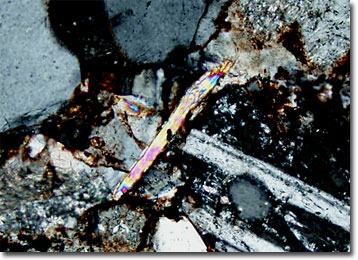Polarized Light Microscopy Digital Image Gallery
Micaceous Sandstone
Sandstones are an abundant sedimentary rock comprised of sand-sized grains of matter. Frequently these small particles are produced by the action of water, wind, and ice on other rocks. However, some sandstones are primarily formed from tiny pyroclastic rocks ejected during volcanic eruptions.

View a second image of Micaceous Sandstone
Though they are primarily comprised of quartz, sandstones may contain a number of other materials as well. For instance, since most sandstones are formed along shallow waters, many samples of the rock include fossilized shells of small sea creatures. Also, in some locations, the rock may contain soft nodules of hematite or limonite that were formerly utilized by many Native Americans as paint pots.
The color of sandstone is as various as its specific mineralogical composition. Shades of red, yellow, orange, gray and brown are relatively common, but green and other varieties also occur, though on a more infrequent basis. Banded sandstones that exhibit multiple colors make particularly beautiful specimens and can often be seen among the expansive sandstone formations located in the western United States.
Micaceous sandstone, which is one of the primary types of sandstone, contains appreciable quantities of mica minerals. The most distinguishing characteristic of these minerals is their ability to be perfectly cleaved into thin, flexible sheets. The inclusion of the platy micas in sandstone deposits is readily apparent to the naked eye, making identification of hand samples of the rock relatively simple. Micaceous sandstones are typically found among rivers and lakes, and although any mica may be present in the rocks, the most common seems to be the light-colored mineral muscovite.
